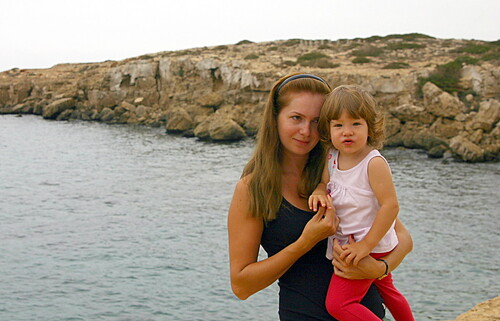 One of my favorite people, and among the wisest of my friends, is my hair stylist, Gina. I always look forward to any time we have to chat while my newly foiled tresses take their color. Recently, we had such an opportunity. We were talking about my work as a Collaborative neutral child specialist, hearing the voices of children whose parents are getting unmarried or separated. Gina shared a story I hadn’t heard, and graciously consented to let me blog about it.
Gina’s parents, like many other couples, went through some very rough patches in their marriage. Because they eventually committed to changing destructive patterns, and worked hard using appropriate community resources, they were able to turn things around in a healthy direction. But not while Gina was a child, after she was nearly grown.
Gina told me that as the youngest child, she had grown up hearing her parents say they would not separate or get a divorce until she had graduated from high school. They may have believed this decision was in her best interests. But to Gina, this decision “on her behalf” made her feel responsible for the conflict and pain that existed in the home. She couldn’t change things on her own, and felt trapped.
She believes that behavior patterns she was forced to normalize by growing up in an abusive family environment impacted her deeply, both as a child and an adult. She has worked very hard to establish healthy patterns for herself, has generously given back to the community, and devotedly raised a fine son. But because early social learning is so powerful in shaping us, she knows she must always be mindful about her adult relationships.
Just staying together when high conflict persists is not a protective factor for children. It is the high conflict itself that inflicts traumatic wounds. Children’s psyches absorb toxic emotional environments just as their bodies absorb lead, and with the same destructive consequences. The decision to separate or divorce should not be made lightly, especially when there are children involved. However, the important question must always be, what needs to be done to keep children out of harm’s way?
For many struggling families, Collaborative Team Practice offers a way to end a high conflict marriage or partnership and begin a healthier pattern of co-parenting after separation or divorce. Children in high conflict families with whom I have met during their parents’ divorce have expressed relief to go home after school to homes that are not filled with stress, anger and anxiety. Please go to www.collaborativelaw.org for more information.
One of my favorite people, and among the wisest of my friends, is my hair stylist, Gina. I always look forward to any time we have to chat while my newly foiled tresses take their color. Recently, we had such an opportunity. We were talking about my work as a Collaborative neutral child specialist, hearing the voices of children whose parents are getting unmarried or separated. Gina shared a story I hadn’t heard, and graciously consented to let me blog about it.
Gina’s parents, like many other couples, went through some very rough patches in their marriage. Because they eventually committed to changing destructive patterns, and worked hard using appropriate community resources, they were able to turn things around in a healthy direction. But not while Gina was a child, after she was nearly grown.
Gina told me that as the youngest child, she had grown up hearing her parents say they would not separate or get a divorce until she had graduated from high school. They may have believed this decision was in her best interests. But to Gina, this decision “on her behalf” made her feel responsible for the conflict and pain that existed in the home. She couldn’t change things on her own, and felt trapped.
She believes that behavior patterns she was forced to normalize by growing up in an abusive family environment impacted her deeply, both as a child and an adult. She has worked very hard to establish healthy patterns for herself, has generously given back to the community, and devotedly raised a fine son. But because early social learning is so powerful in shaping us, she knows she must always be mindful about her adult relationships.
Just staying together when high conflict persists is not a protective factor for children. It is the high conflict itself that inflicts traumatic wounds. Children’s psyches absorb toxic emotional environments just as their bodies absorb lead, and with the same destructive consequences. The decision to separate or divorce should not be made lightly, especially when there are children involved. However, the important question must always be, what needs to be done to keep children out of harm’s way?
For many struggling families, Collaborative Team Practice offers a way to end a high conflict marriage or partnership and begin a healthier pattern of co-parenting after separation or divorce. Children in high conflict families with whom I have met during their parents’ divorce have expressed relief to go home after school to homes that are not filled with stress, anger and anxiety. Please go to www.collaborativelaw.org for more information.  Working with children, I became a Harry Potter fan out of both necessity and real appreciation. J.K. Rowlings’ world of wizards and magic is a fantasy, but the themes of these books are human and real. Among the most frightening characters in Rowlings’ epic struggles of power and control, good vs. evil, are the Death Eaters and the Dementors.
Working with children, I became a Harry Potter fan out of both necessity and real appreciation. J.K. Rowlings’ world of wizards and magic is a fantasy, but the themes of these books are human and real. Among the most frightening characters in Rowlings’ epic struggles of power and control, good vs. evil, are the Death Eaters and the Dementors.
The Death Eaters are those in the wizard world who have made a pledge to support Lord Voldemort, whose vision of total domination rather than peaceful co-existence has been distorted by his hate and rage, and obsession with destroying Harry Potter. The Dementors are the terrifying, soul-sucking wraiths who feed on fear. What a relief that Death Eaters and Dementors aren’t real and aren’t about us! But Rowlings has created a thought-provoking twist.
By the last book, Harry Potter has discovered that he and Lord Voldemort have much in common. Harry alone must determine whether he is capable of making the necessary sacrifice for the greater good of those who depend on him to be their champion. Harry must defeat the Death Eaters and Dementors by conquering his own fear and rage with selfless love. Harry is not perfect, he has made many mistakes and hurt the ones he cares about, but he has this gift within him waiting to be discovered at the time of ultimate crisis.
What I find compelling about the Harry Potter books is the mirror they hold to our world. In our humanity, we all find ourselves having to figure out how to resolve inevitable conflicts and manage strong negative emotions. Parents and children facing divorce are certainly living through an emotional crisis. The question is, do we let rage and fear drive and perhaps distort our actions, or do we seek another way, one that may ask us to sacrifice power and control for the greater good of those who depend on us to be their champions–our children.
Collaborative Team Practice is an alternative dispute resolution process using interest-based negotiation and problem solving to reach agreements and sustainable resolutions. On the team, allied and neutral professionals provide support and guidance to manage strong negative emotions, suggest creative and equitable financial resolutions, and negotiate safe, developmentally responsive parenting plans. It can be a highly effective way to help families transition respectfully during the crisis of a divorce.
We know Collaborative Team Practice may not be the right choice for all families. However, it is a process that will work for many families. Our belief is that reaching agreements rather than perpetuating conflict is truly the way to be champions for children in the age of Death Eaters and Dementors.
- Realize that it’s not about you. This is so critical that it bears repeating … it’s not about you! Your children need your love and support, especially during times of change. It’s your job to provide that love and support. If possible, choose a divorce process that keeps your children out of the middle. Do whatever is necessary to get over the reasons for the divorce. You will be a healthier person if you can find a way to let go of past resentments. If you need help doing so, find a good therapist and do the work. If you’re reluctant to do it for yourself, do it for your kids!
- Set a positive tone. Your attitude toward life is contagious and your children will “catch it.” Tune out our culture’s message that divorce is always bad for kids. Tune out the negativity expressed by well-meaning friends and family, who may be more than eager to share their stories. Work on reducing your reactivity to everyday situations through relaxation, mediation or yoga. Your kids are watching you to gauge how things are going. Show them that you’re all right. This doesn’t mean pretending that all is perfect. Life presents many challenges. Divorce can be an opportunity for you to model resiliency.
- Listen. Make time each day to be fully available to each of your children. It’s easy to get caught up in the busy-ness of normal, everyday life. This is especially true when you’re in the process of redefining “normal.” Turn off the TV and cellphones for a few minutes each day so that you have each other’s undivided attention. Encourage your child to share her feelings and experiences. Ask open-ended questions, which invite sharing without pressuring them. Regular check-ins will make it more natural for your children to express themselves when they experience problems.
Several times a year, I have the opportunity to present a workshop on child-centered divorce, parenting plans and co-parenting to Daisy Camp. Daisy Camp is the brainchild of Jennifer Morris, a realtor who has realized her vision of providing women with important resources and support during and after a divorce. Jennifer assembles volunteer speakers, many of whom are Collaborative Team Practice professionals, to share information and facilitate discussion on a range of divorce-related topics. Daisy Camp is an amazing Minnesota resource.
At the most recent Daisy Camp, I was pleasantly surprised when a former Collaborative client joined the group right before my presentation. I had provided neutral child specialist services for her family a year ago, meeting with her children to understand their perspectives on how family could work best for them during and after their parents’ divorce, and assisting parents in the creation of their developmentally responsive parenting plan. My client told the group she was there for a refresher on child-centered co-parenting, especially with an ex she often found frustrating to work with. Other women in the group shared stories and concerns about the challenge of keeping children at the center and out of the middle. We discussed the impact of divorce on kids, and the importance of keeping a crisis from becoming a trauma for children. Our discussion was thought-provoking and emotionally powerful. At the end of the workshop, my former client revealed how difficult it had been during her divorce process to internalize messages about keeping children at the center and out of the middle, not blaming the other parent, and preserving her kids’ relationships with someone by whom she felt so betrayed. She has remained on a co-parenting high road on behalf of her children, even when she felt she was doing this unilaterally, and is more convinced than ever that this has been of benefit to her children and is the right thing to do. This personal revelation was a gift to the group. Her final gift to the group was a heartfelt message of hope. She said while she was in the midst of a highly stressful divorce, she couldn’t have imagined how much healing could happen in a year. Her parting words, “Believe me, it gets better!” rang strong and true, both for her, and equally importantly, for her beloved children. The “Rule of Relationship” is one of the most powerful forces in our lives. Often we are not even aware of its existence. In a divorce, it can be more powerful than the rule of law.
Here is how it works. Let’s assume you and your spouse are separated but you do not have any legal document regulating your separation or parenting. You have informally agreed to share weekends with the children and you pick the children up from your spouse’s home of Friday, promising to return them by 6:00 p.m. on Sunday. What if you decide not to return the children at that time? You will not have broken any law since there is no divorce or court order. Yet the consequences of your decision may be even more severe than any punishment a court could order as you have violated the “Rule of Relationship.” You may have damaged trust in a manner that could be very difficult to repair.
Maintaining some level of trust is crucial in almost all situations. It is tempting to think that, in a divorce, there is no trust. Indeed, your spouse may even have been unfaithful causing you to believe that all trust is lost. But, in reality, there is almost always some degree of trust that exists in any relationship. If you literally had no trust at all, you would not ever allow your spouse to even be in the presence of your children, since you need to trust them to provide for their well being and safety, for at least some portion of their week. Despite the broken promises that can give rise to a divorce, most people are able to find a way to retain some basic level of trust, out of necessity and concern for their children.
Trust is generally regulated by the “Rule of Relationship” and not by laws. Trust can only be created or lost through behavior. When it comes to regulating day to day behavior no court or government, no matter how well intended, can intervene on a daily basis to address these difficult situations. Parents are often left with their own laws, the Rule of Relationship,” to help them parent their children and regulate their lives. That is one of the reasons more and more parents are choosing out of court solutions, such as Collaborative Practice, to help them resolve their issues out of court.
Working parenting issues out of court, where the laws of relationship and responsibility can help rebuild trust, can help your parenting plan go more smoothly and gives your children a true role model for developing trust in their lives.
The “Rule of Relationship” is one of the most powerful forces in our lives. Often we are not even aware of its existence. In a divorce, it can be more powerful than the rule of law.
Here is how it works. Let’s assume you and your spouse are separated but you do not have any legal document regulating your separation or parenting. You have informally agreed to share weekends with the children and you pick the children up from your spouse’s home of Friday, promising to return them by 6:00 p.m. on Sunday. What if you decide not to return the children at that time? You will not have broken any law since there is no divorce or court order. Yet the consequences of your decision may be even more severe than any punishment a court could order as you have violated the “Rule of Relationship.” You may have damaged trust in a manner that could be very difficult to repair.
Maintaining some level of trust is crucial in almost all situations. It is tempting to think that, in a divorce, there is no trust. Indeed, your spouse may even have been unfaithful causing you to believe that all trust is lost. But, in reality, there is almost always some degree of trust that exists in any relationship. If you literally had no trust at all, you would not ever allow your spouse to even be in the presence of your children, since you need to trust them to provide for their well being and safety, for at least some portion of their week. Despite the broken promises that can give rise to a divorce, most people are able to find a way to retain some basic level of trust, out of necessity and concern for their children.
Trust is generally regulated by the “Rule of Relationship” and not by laws. Trust can only be created or lost through behavior. When it comes to regulating day to day behavior no court or government, no matter how well intended, can intervene on a daily basis to address these difficult situations. Parents are often left with their own laws, the Rule of Relationship,” to help them parent their children and regulate their lives. That is one of the reasons more and more parents are choosing out of court solutions, such as Collaborative Practice, to help them resolve their issues out of court.
Working parenting issues out of court, where the laws of relationship and responsibility can help rebuild trust, can help your parenting plan go more smoothly and gives your children a true role model for developing trust in their lives. - How can we create a parenting plan that will benefit our children?
- How can we divide our assets fairly?
- How can we maintain control of divorce costs?
 Besides being a family law attorney, I am a divorced mother of a teenager. My daughter was 9 when her dad and I separated. Parenting is not for the faint of heart, even with a great kid. I cherish the fact that I have a strong co-parenting relationship with my daughter’s father as we celebrate the successes and face the challenges of launching a young woman into independence.
So it bothers me when I see divorced women torpedoing the co-parenting relationship. I don’t seem to attract these kind of women as my clients, but I meet them socially or hear the stories from others (None of the moms below were my clients). The following is my advice to those women, because I have lived it.
Besides being a family law attorney, I am a divorced mother of a teenager. My daughter was 9 when her dad and I separated. Parenting is not for the faint of heart, even with a great kid. I cherish the fact that I have a strong co-parenting relationship with my daughter’s father as we celebrate the successes and face the challenges of launching a young woman into independence.
So it bothers me when I see divorced women torpedoing the co-parenting relationship. I don’t seem to attract these kind of women as my clients, but I meet them socially or hear the stories from others (None of the moms below were my clients). The following is my advice to those women, because I have lived it.
1. Stop calling yourself a “single mother.” Unless your child’s father died or has no involvement in your child’s life, your child still has a dad. Calling yourself a single mom marginalizes dad. I know of a mom who sent dad a copy of the registration form for summer camp, since dad was paying half the cost of extra-curricular activities. Mom put her name and contact information on the form and drew a line through the section for the other parent. Even if you have sole custody, respect the fact that your child has two parents. 2. Communicate, communicate, communicate. Dads need to know what is going on with kids when they are at mom’s home, and vice versa. I know of a dad who reached out to mom to discuss how to handle a power struggle. Mom responded by saying, “That’s between you and [daughter]. You have to figure it out on your own.” I wonder if mom would have said the same thing to a teacher asking for input. This isn’t a test where comparing answers is cheating. This is your kid’s life. And don’t forget there will likely be a time in the future where you are struggling to find the answer to a parenting dilemma. It is a relief and a blessing to have a co-parent when that happens. 3. Communicate doesn’t mean micro-manage. The flip side is the mom who is hyper-vigilant and second-guesses every decision, monitoring every meal and activity. I know a mom who was critical because dad ate out at restaurants too much. Give yourself permission to let go of the small stuff.When my daughter was younger, she was on a soccer team but was tired of going to practices. She was at my house and was supposed to be picked up in the carpool. What I didn’t realize is that she texted her friend and said she wasn’t going to practice, and then she left the house and re-entered through the egress window in the basement. I found her hiding out in the basement. It was a relief to be able to call her dad and have a unified approach to dealing with honesty, and to also re-assess soccer as an activity for her. Unless there are domestic violence issues, do whatever you can to nurture a parent partnership. Let go of competition with dad. Let go of anger towards dad. Let go of perfection. Trust me, life is so much better, for your kids and for you, when you have a co-parent.
 I recently saw the new Woody Allen film, Blue Jasmine. It stars Cate Blanchett and Alec Baldwin as a couple who live the high life and then the low life following divorce. The story line and themes in this movie seemed true to me based on my work with many divorcing couples, not just those who are wealthy.
There were the underlying issues in the marriage–the husband’s cheating, both with sexual affairs and financial fraud, and the wife’s complicity through passivity and claimed ignorance (although she knows more than appears). There was denial by both of the problems, which included mental health and drinking issues. For the wife in this movie, her loss of self and identity following the separation and divorce was shattering and, in the end, her emotional choice to revenge resulted in enormous cost and loss to both of them.
I am not saying that all divorces follow all of these themes in this movie. Like an opera, the movie highlights some dramatic truths about human nature and patterns in relationships.
One pattern is that problems during the marriage which have not been addressed can pop up and control the divorce process, sabotaging efforts to reach a settlement. This doesn’t mean that a couple has to “fix” all the troubles leading up to the divorce, but could require acknowledgement of the problems and work toward a future that addresses the realities of their situation. So, for the couple in Blue Jasmine, it would be addressing the mental health needs and possible alcoholism treatment for one or both, college education for wife, and a top notch criminal defense attorney for husband.
The instinct for revenge, which often causes hurt to both in the divorce, can be defused in a collaborative divorce process which focuses on the collective outcome for the family as a whole. In Blue Jasmine, that would include the outcome for their son, who was hurt by the divorce, and for the parents.
I recently saw the new Woody Allen film, Blue Jasmine. It stars Cate Blanchett and Alec Baldwin as a couple who live the high life and then the low life following divorce. The story line and themes in this movie seemed true to me based on my work with many divorcing couples, not just those who are wealthy.
There were the underlying issues in the marriage–the husband’s cheating, both with sexual affairs and financial fraud, and the wife’s complicity through passivity and claimed ignorance (although she knows more than appears). There was denial by both of the problems, which included mental health and drinking issues. For the wife in this movie, her loss of self and identity following the separation and divorce was shattering and, in the end, her emotional choice to revenge resulted in enormous cost and loss to both of them.
I am not saying that all divorces follow all of these themes in this movie. Like an opera, the movie highlights some dramatic truths about human nature and patterns in relationships.
One pattern is that problems during the marriage which have not been addressed can pop up and control the divorce process, sabotaging efforts to reach a settlement. This doesn’t mean that a couple has to “fix” all the troubles leading up to the divorce, but could require acknowledgement of the problems and work toward a future that addresses the realities of their situation. So, for the couple in Blue Jasmine, it would be addressing the mental health needs and possible alcoholism treatment for one or both, college education for wife, and a top notch criminal defense attorney for husband.
The instinct for revenge, which often causes hurt to both in the divorce, can be defused in a collaborative divorce process which focuses on the collective outcome for the family as a whole. In Blue Jasmine, that would include the outcome for their son, who was hurt by the divorce, and for the parents.  Divorce is never truly good. But a bad divorce can create many years of devastation. If you have a friend or family member approaching divorce it can be difficult to watch the economic and emotional turmoil unfold, particularly if there are children involved. As a friend, or a family member, you want to help; but can you?
In my 30 years as a divorce lawyer, I have seen how friends and family members can provide much needed support and comfort that has helped my divorce clients get through this process in a much healthier way. At the same time, I have often watched well meaning friends and family members give my clients advice that actually made the divorce more adversarial.
If you know someone who is going through divorce and want to help, here are five things to consider.
Divorce is never truly good. But a bad divorce can create many years of devastation. If you have a friend or family member approaching divorce it can be difficult to watch the economic and emotional turmoil unfold, particularly if there are children involved. As a friend, or a family member, you want to help; but can you?
In my 30 years as a divorce lawyer, I have seen how friends and family members can provide much needed support and comfort that has helped my divorce clients get through this process in a much healthier way. At the same time, I have often watched well meaning friends and family members give my clients advice that actually made the divorce more adversarial.
If you know someone who is going through divorce and want to help, here are five things to consider.
- Encourage them to seek counseling, if appropriate. Whether they are trying to save the marriage or simply manage the emotional turmoil and grief during this difficult time, a good counselor can be even more important than a divorce attorney. They will soon be making some of the most important decisions in their lives during a time in which their sense of reason and judgment may be impaired by emotions. Getting help with the emotional and psychological aspect of divorce is crucial.
- Give them support and encouragement; but not legal advice. If you have been through a divorce, or have experienced the divorce of close friends, you may be tempted to advise others based on your observed experience. This advice, though well intended, can often be quite harmful.
- Encourage them to truly research their options. Most people rush into divorce without truly understanding their choices. As result they often choose a method that is not the best alternative for their family.
- Help them understand that civility is not weakness. Divorce can create fear and anger that tempt people to seek “a pound of flesh.” Few families can emerge from an adversarial divorce unscathed. Help them understand that resolving their divorce in a civil and respectful manner can actually get them a better outcome.
- Avoid demonizing the spouse. Divorce often creates a delusional reality that causes people to see their spouse in a very negative light. Accepting your friend’s emotionally impacted negative view off their spouse can even seem like the “supportive thing to do.” Usually it simply adds to the misperceptions that make future co-parenting more difficult.

